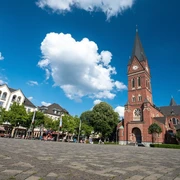The Auferstehungskirche church was consecrated on 8 May 1825. The builders of this church made use of the formal language of antiquity, since for them, this meant a small piece of paradise on Earth. The yearning for the reality of God, for a world as they would like to see it, was expressed at the time with the aid of this architectural style.
This was known as classicism. It is closely connected with Karl Friedrich Schinkel. He worked intensively on the construction of the Auferstehungskirche. The design did not originate with Schinkel himself. However, he did assess and correct the plans. He later said that the finished church was a success.
The classical quarter around the church was also built during this time. As the “Prussian government quarter”, the construction of residential buildings and also the new church was generously supported by the Prussian king Friedrich Wilhelm III.
The classical elements in this church have a symbolic meaning: there are 8 Doric columns as in a Greek temple. They enclose the central building of 1824, which is built on the ground plan of a Greek isosceles cross. These columns symbolise the connection between heaven and earth.
In ancient times, the palm tree was considered as the tree of life and of God. We find it as a stylised palm tree top on the ceiling and in the pulpit.
The baptism font is designed after an antique sacrificial bowl. Four legs with lions’ feet demonstrate the strength that lies in the sacrament of the baptism. One special feature is the pine cone in the wreath of leaves on the lid of the font. The pine is a typical Mediterranean tree. The cone is the symbol of fertility.
Rosette and acanthus leaves form the garland at the altar. The large amount of gold is a reminder of the shining presence of God. The blue tones in the church indicate heaven and infinity.
The altar painting was painted in 1834 by the artist Ernst Deger and shows Christ after being resurrected. Ernst Deger belonged to the Nazarene group of artists. At that time, this painting was considered one of the best of its time. Incidentally, in 1967 in connection with the consecration of the Erlöserkirche (church of the redemption), this church was named after this altar painting.
In 1890/91, an extension was added to the church due to a lack of space. The seam is marked by two cast-iron pillars with vegetation as decoration: vine leaves, palm leaves and acanthus.
The windows in the altar room were installed during the renovation work of 1951/52 to replace the windows destroyed during the war. They were probably designed by Professor Thol, who was responsible for the renovation. The words of the Bible on the label surrounding the altar room relate to the altarpiece, the church windows, the baptism and the sermon.
The relief in the altar room is a piece by sculptor Georg Hartje from Langscheid. It was created in 1952 in memory of the victims of the two World Wars.
The organ, which was built in 1969, was made by the famous organ builder Hammer from Hanover. This organ is particularly suitable for playing Baroque organ music.
In December 2001, the interior renovation of the Aufterstehungskirche was completed. As well as painting in the original colours, new toilet facilities were built, a kitchenette was installed, the vestry was moved behind the altar, a movable glass folding wall was built in and the equipment needed for exhibitions was installed.
The Auferstehungskirche was awarded the “Church with reliable opening hours” plaque. A globe prayer candle holder was procured for the work of the Open Church, which invites visitors to pray and light a candle. The “Arnsberg Bible 2001” is exhibited in the Auferstehungskirche. Many people from Arnsberg wrote words from the Bible, added their comments and were involved in the design.
Text modified from the original by Adelheid Philipps
Opening hours, “Open Church”: Wednesday, Thursday, Friday: 10.00 am - 12.00 midday and 3.00 pm - 5.00 pm, and on Saturdays during the summer months: 10.00 am to 12.00 midday
Service: Sundays 9.15 am
Good to know
Openings
Price info
Author
Sauerland-Tourismus e.V.
Organization
Sauerland-Tourismus e.V.
License (master data)
Sauerland-Tourismus e.V.
Nearby






